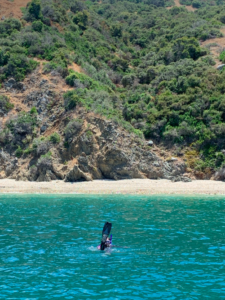By the end of this blog entry, trust me, you will know. From July 15th to the 25th I had the pleasure of assisting on several different research projects around Catalina Island, California. After packing personal gear, dive gear, an inflatable boat, motor, and research gear from Moss Landing Marine Operations we set off for San Pedro. From San Pedro to Catalina (about a 5-hour drive), we discussed research projects and I grew more and more excited for diving around the island.
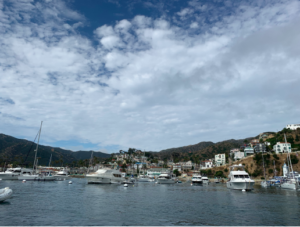
Avalon, Catalina Island
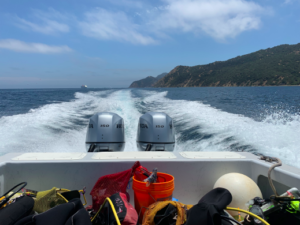
A clear day for diving at Avalon!
Diana Steller and Matthew Edwards are co-principal investigators on the main research project titled “Minimizing disturbance impacts by California vessel mooring systems on living rhodolith benthos in Catalina MPAs: an experimental assessment”. The project objectives are: “to identify and experimentally evaluate potential vessel mooring systems that may reduce impacts to rhodolith beds and other sensitive Catalina Island benthic habitats; to identify a suite of efficient field metrics to rigorously monitor integrity and recovery of rhodolith habitats; and to assess productivity and ecosystem functioning of rhodolith beds in order to evaluate restoration potential for recovery of impacted habitat.” (Steller & Edwards, SeaGrant). This involves many hours of scientific diving, lab work, and a few boxes of Oreos for energy.
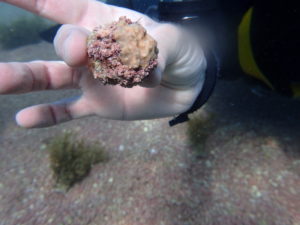
A round rhodolith!
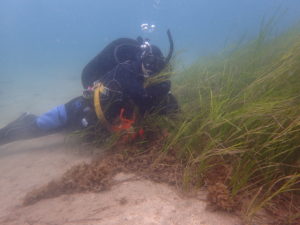
Scottie loves his greens!
Right on the day we arrived at Two Harbors (Big Fishermen’s Cove), I dove with the Survey Team at Emerald Bay. The Survey Team consisted of Diana Steller (Research Faculty/DSO of MLML and my internship host), Scott Gabara (Ph.D. candidate at San Diego State University and former MLML student), June Shrestha (MLML graduate student), and myself. Throughout the trip, we went to 6 different study sites and conducted benthic surveys inside and outside rhodolith beds.
Each of us had a different task and would attempt to complete them on dives that were a little over an hour long each. June conducted fish surveys and Scott would lay out the transect, identify the benthic substrate, count and identify the associated organisms on top of the rhodoliths within a 20 m transect. Diana and I would work with Scott on the same transect and use a 25 cm x 25 cm quadrat for substrate percent cover and we dug for organisms like snails, sea stars, urchins, and other small creatures. We also obtained sediment cores to collect live and dead rhodoliths to do size frequencies (where we took abundance in each size class and measured the volume).
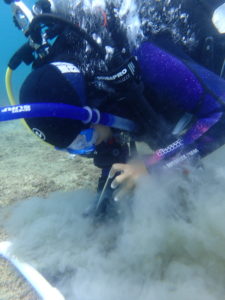
Getting a rhodolith core isn’t as easy (or clean) as you think…
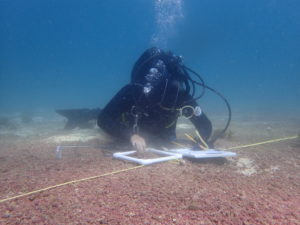
Scottie surveying the rhodolith bed using a quadrat.
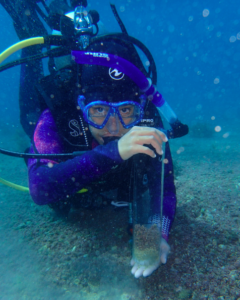
Me holding a lovely rhodolith core.
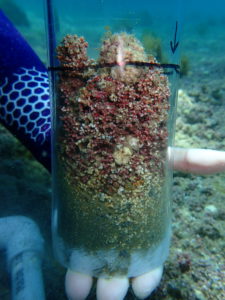
A clean and clear core.
Another section of the Rhodolith project involved deploying underwater chambers. There were 10 chambers in total, some located within rhodolith beds and some on top of crushed rhodolith/sand habitat. Inside the chambers were sensors that took measurements of water quality. During chamber surveys, benthic details and cores are taken as well. An additional part of the chamber experiment involved crushing of the rhodoliths with chains to mimic the crushing action of mooring chains. A Tupperware, rigid cylinder, and a spoon were used to collect live rhodoliths in order to bring them back to the lab to find size-frequency for each within and outside rhodolith bed samples.
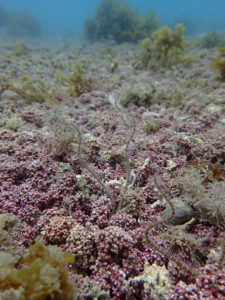
Some brittle stars wanted to say hello! (Look close and you can see their arms)
Now on to the important part: what is a rhodolith? How does it form a bed? Most people don’t know what rhodoliths are. One day, a local boater on Catalina asked us what we were diving for and we responded “we’re observing rhodolith beds” and he replied that there isn’t much to see there within the bays. But truthfully, a rhodolith bed is a whole new world. If you look up a rhodolith on Wikipedia, you’ll read that rhodoliths are “ colorful, unattached, branching, crustose, benthic marine red algae that resemble coral. Rhodolith beds create biogenic habitat for diverse benthic communities.” This is definitely true plus they deposit calcium carbonate within their cell walls so they form small hard structure just like hard corals do. However, rhodoliths are unlike coral since they don’t attach themselves to any rocky substrate or seabed. That’s why they’re often called tumbleweeds because they roll around the sand and have thin branches. Rhodoliths are autotrophic and produce energy through photosynthesis so they only survive in the photic zone where it’s shallow and light can reach the little rhodoliths.
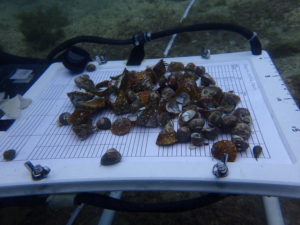
Snails love rhodoliths!
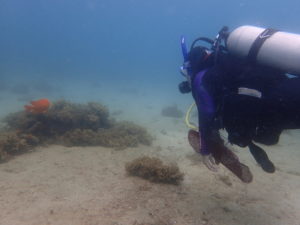
A Garibaldi wanted to say hello during our research dive! First time I saw one.
There were two main tasks that had to be done in the lab: size frequency and core live/dead processing. To do a size-frequency, we 1) separate live rhodoliths into three different size classes 2) count the number of rhodoliths in each size class 3) measure the volume of each size class along with the dry mass of the rhodoliths once they’re entirely dry. We did the same thing with the sediment cores without separating them by size, just by live and dead ones.
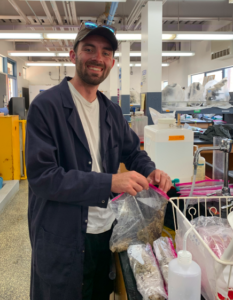
Dillon Dolinar (SDSU) happily removing water from a collected core.
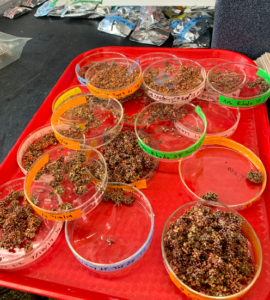
Samples in their Petri dishes
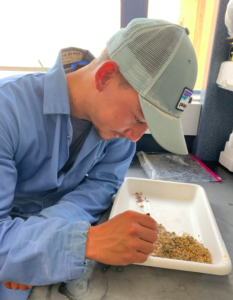
Darrin Ambat (SDSU) sorting live and dead rhodoliths collected from a core.
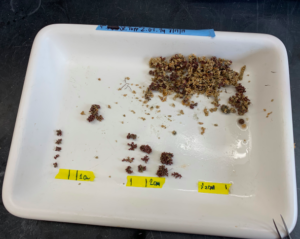
Upclose with size-frequency rhodoliths
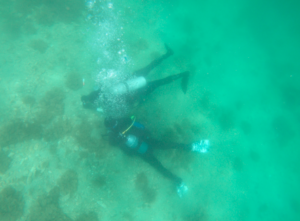
Dillon and Ehrick placing snails that were tagged at Isthmus Cove.
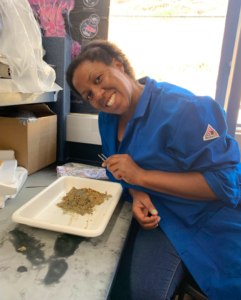
Charnelle happily sorting live and dead rhodolith from a core.
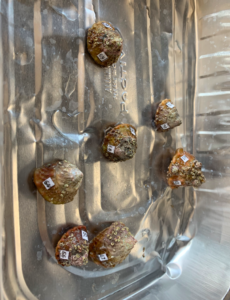
Freshly tagged snails.
Charnelle Wickliff, a student of California State University Monterey Bay and Moss Landing, has a project with the goal of measuring snail growth and movement between rhodolith beds, rocky reef, and kelp forest. This involved collecting Megastraea sp. from the rhodolith beds, measuring the width, and tagging them with a number using super glue (without gluing your fingers together). The snails were returned to the beds with markers. Charnelle will return to those markers and resample the area to find the snails and reevaluate their growth and movement between habitats.
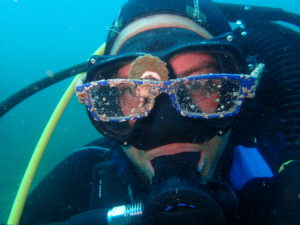
Fun finds on a dive at Avalon! Plus a snail wanted a picture of itself!
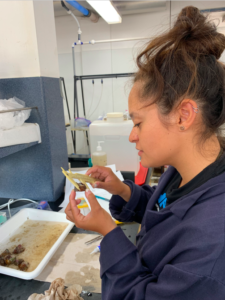
Me measuring the width of one of our lovely snails.
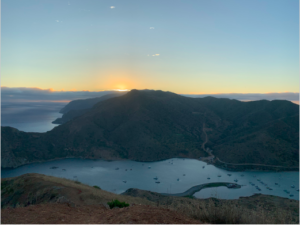
Cat Harbor during an evening hike.
I will definitely miss the fun times, diving, and sunsets at Catalina! Stay tuned for my next blog post on the next chapter of my internship: AAUS Scientific Diving Course!
